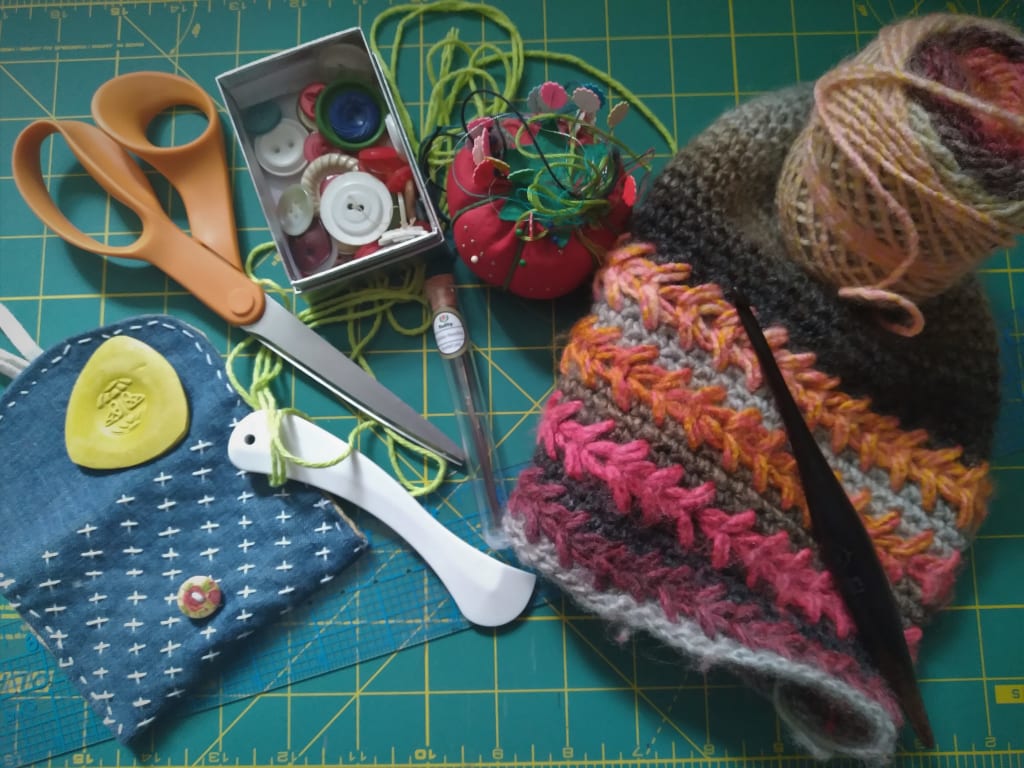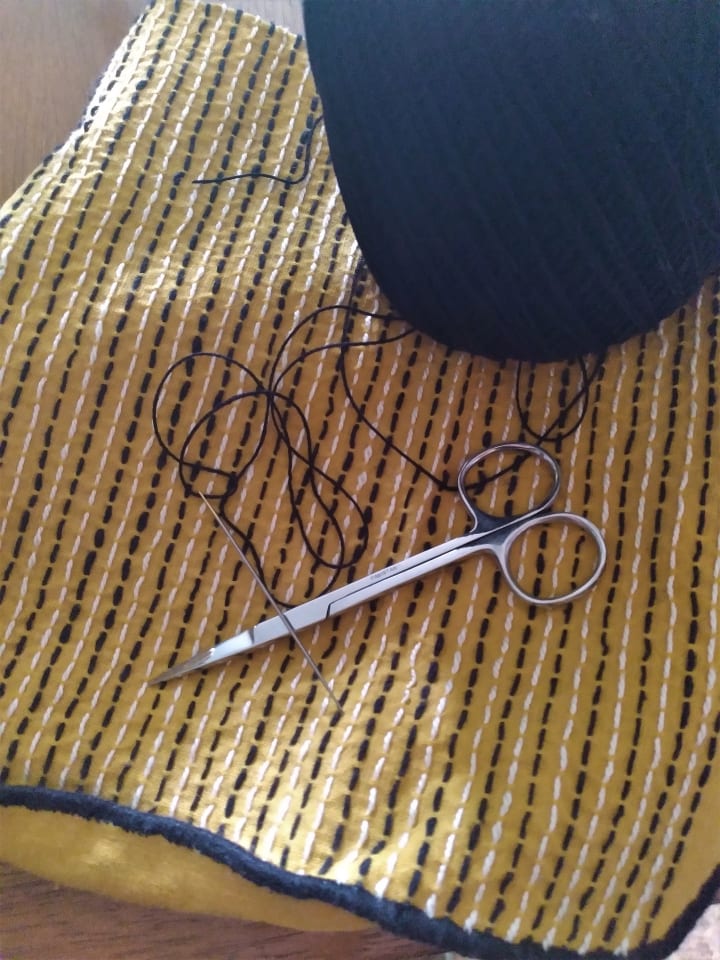Snip Stitch Snip
Reclaiming The Joy in Making

I majored in studio art in college, I had always loved being creative and it seemed like the right step to take. Painting, photography, printmaking, drawing-all these art forms were ones that I longed to be better at. I practiced hard and gained considerable skill, but to be honest, what I was the most exceptional at was the process. Sure, I could take a good photo, but I was better at developing the photographs. I could come up with a good idea for printmaking, but I excelled at the tightly controlled process of actually making the print. I thought it was more fashionable to be creative and come up with genre shattering ideas. Skill always seemed like a silver medal, nice, but not great. This was also a time where I was exploring my place in the world without my parents directly at my side, seeing who I was in the scheme of things. After a little adjustment, it turned out I was a minty fresh feminist artist. There's a brashness that comes with that first step, a kind of grabbing of rights, an insistence of recognition and equality. Those days are important to every woman that experiences them. It's the lighting of a fire. I shunned traditional female roles, don't want to cook? Don't. Don't want to wear skirts? #pantsforever. No bra? Done. Those first changes are like a vibration altering all facets of your life and sometimes are more black and white than they need to be. I don't judge that woman, she had sass. Art is a wonderful way to discover yourself. Art finds you on the surface-shimmering and obvious, and it finds you deep inside where you are sometimes afraid to look. I thought that my art had to reflect the new me, a visionary, someone who only looked forward and not back. Then an assignment came: use traditional "women's work" to express yourself. I was so angry about it because, to me, it meant that I would be turning back the clock on all the progress I had made and doing the things that I thought I wasn't supposed to do any more. I'd already thrown off those shackles, why the hell would I put them back on willingly? Sewing, knitting, crochet, that all seemed so anathema to me and the person I was becoming. It didn't matter that when I was younger, I found washing and ironing my mother's vintage doll clothes so pleasing. It didn't occur to me that designing art house clothing for my Barbie dolls and sewing them by hand was anti-feminist. I didn't even think about how my friends and I would make colorful scarves and skirts and bags and dresses so we could stand out in a sea of girls dressed in clothes from The Limited. No, this project, for some reason, was a threat. I did it, of course, it was an assignment after all. Though I barely remember, I think I made boudoir pillows and embroidered witheringly sarcastic sayings about 'a woman's place' on them. *Dust Hands* Feminist mission accomplished.
Fast forward a bit, fast forward through the messy years. The years that I was lost, or hurting, or a train-wreck. The years where I was challenged to grow up. I lost bits of my old self while I tried to figure out who the hell I was to begin with and what I was about to become. Those years weren't all that creative, the process just kind of stalled out in my heart. I probably did more house painting than fine art painting, landscaping flowers rather than drawing them. I don't remember the exact day, but I remember clearly that I wanted to learn how to crochet, for real this time. I watched videos trying desperately to understand the magic that was happening. It seemed like the first few steps were easy and then presto! crochet. No matter how many times I watched, I missed some crucial point and nothing I made looked like it should. I searched in yarn and crafting stores for someone to just show me a quick stitch but I am sad to say that no one had the time. I am lucky enough to have a community college close by with an amazing art program that included a fiber arts department. With some gumption, I managed to snag a one on one with a professor of fiber arts. She patiently showed me how to hold my hands, how to hold the hook, how to work stitch by stitch and slowly I was able to crochet. I felt like I was weaving a spell! Gone was the woman who held this craft in disdain. I was a woman who learned something useful, and I was proud. What had changed from that long ago day when I had so brutally rejected crafting as an art form? I grew up, I grew softer and more understanding. I grew to understand that crafting is a tradition of skills, a beautiful remaking of the world to cherish and enjoy. Since then, I've made Halloween costumes for my son (who of course cannot pick anything simple), purses and bags, scarves, hats, fingerless gloves, masks.
A few years ago I was gifted a class on Sashiko stitch work. I had never heard of this craft and was delighted to learn that it was a skill and an art form. Sashiko stitch work is a traditional Japanese embroidery style that consists of tiny, grains of rice sized stitches on cotton or hemp fabric. There are simple designs and designs that will boggle your mind in complexity, but the designs have use. Sashiko is a mending skill, used by women to mend work clothing, warm clothing, loved clothing. The designs could indicate what kind of industry a person worked in, or what they loved, or where they were from. For me, it was a completely new and different way to approach sewing and mending. I hadn't even known that "visible mending" was a thing. A rip was something that you needed to do your best to hide with almost invisible stitch work. Visible mending is like a scar you are proud of. A badge that you loved something so much, you didn't want to give it up. The first project I completed was a little sewing pouch at the workshop. You'll see it in the left hand corner of the first photo. That little thing is one of the most useful and used things I've ever made.

I quickly learned that Sashiko stitching really takes a toll on needles. I had been using milliner's needles to do most of the work, but I found that the running stitch style bent the needles. I ordered myself true Sashiko needles from Japan and marveled at how sharp and sturdy they were. There is something so pleasing about making things, Sashiko especially. I love the sounds and the motions of it. The sound of the iron as it quietly chuffs out steam as you press. The soft chalk triangles gliding against the fabric marking the pattern. The way a pair of scissors makes that almost metallic chewing noise, and the way it deftly cuts through cotton. The sharp chirp of the blades as they snip the cotton thread, like they've got a sweet little song built up in them coming out note by note. You can hear the needle too, hear it playing the fabric as it punches into the cotton and pulls through the thread. There is something so primal and female about thread and scissors. It reminds me of the three fates, spinning the thread of life, measuring it and then eventually cutting it. As if all of life was women's work. I am delighted, now, to be continuing the tradition of women's folk art. I wanted to be a cutting-edge artist, but it turns out I am far more comfortable as an artisan. A maker of beautiful and useful things, and a lover (and caretaker) of the tools and materials I use to make them.
About the Creator
Sarah Snider
I am a great lover of poetry, magic, mystery and science. I am passionate about sharing what I know about herbs and herbal medicine.
She/Her






Comments
There are no comments for this story
Be the first to respond and start the conversation.